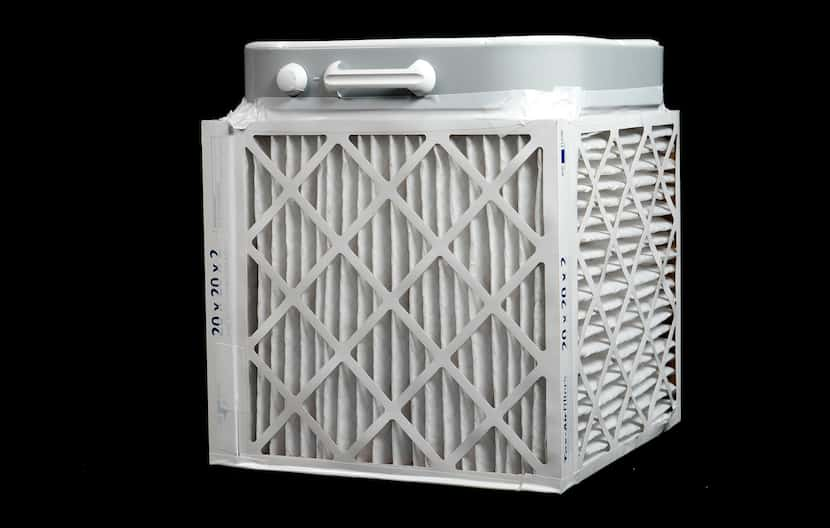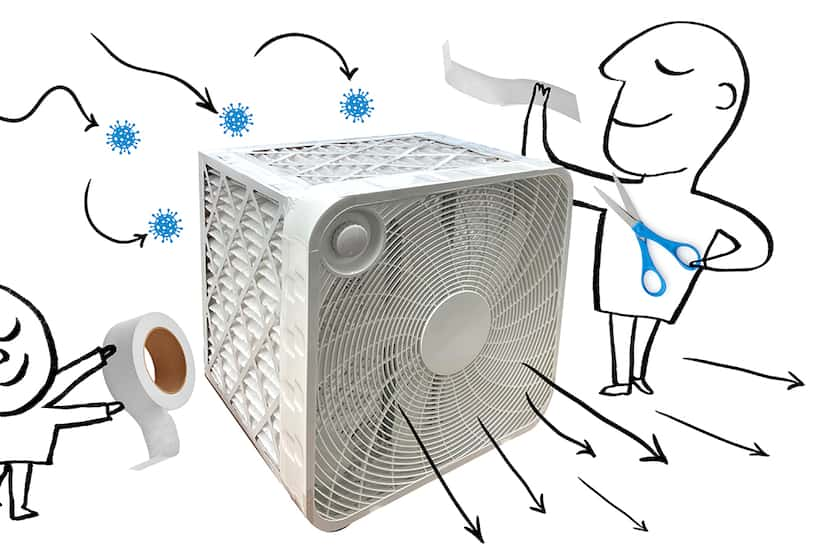Life in North Texas has largely returned to a pre-pandemic normal. People are tired of masking and remaining socially distant, even though contagious COVID-19 variants show no signs of going away anytime soon.
With attitudes toward COVID-19 becoming increasingly lackadaisical, public health experts are touting ventilation as a less-intrusive way to stop tiny particles carrying the virus from traveling through the air. But adoption of better ventilation practices — which can range from expensive to unrealistic — has been slow.
Enter the Corsi-Rosenthal Box, a do-it-yourself air filtration system with North Texas ties that has taken the internet by storm. Each box typically costs under $100 to make and is more effective than other, pricier options like High Efficiency Particulate Air filters.
The simple contraption consists of a box fan, four MERV13 furnace filters that can be purchased online or in store, some cardboard and strips of tape. It’s the brainchild of air quality researcher Richard Corsi, dean of engineering at the University of California, Davis, and Jim Rosenthal, CEO of Texas-based company Tex-Air Filters.
“It was an exercise of, ‘How do we build something that might still be pretty effective at a much lower cost?’ That was the goal,” Corsi said. “And it was just kind of sketching something out and realizing that just $20 box fans produce much higher flow rates than the fans that are in HEPA air filters.”
Ventilation, which exchanges stale air for fresh air, can take many forms. Just opening windows can increase the amount of air moving through a room, although that’s not always an option in the Texas heat. Older buildings’ ventilation systems often can’t cycle enough air in and out to sufficiently remove the droplets that COVID-19 clings to.
“I think we’re beginning to realize that we need a three-pronged approach to controlling COVID. One is vaccination, masking and then ventilation,” said Catherine Troisi, an infectious disease epidemiologist with the University of Texas Health Science Center at Houston. “And we just haven’t paid enough attention to ventilation since the start of this pandemic.”
The White House launched the Clean Air in Buildings Challenge in March, calling on building operators, like schools and companies, to up their inside air quality.
But interest in such investments has been weak, even with billions of dollars in federal COVID-19 funding for schools that can be used to upgrade ventilation systems.
Portable air filters can make up for outdated ventilation systems, although they tend to come with hefty price tags. Standalone devices that use HEPA filters can cost upwards of $300 to $400, and that doesn’t include the price of filter replacements.
So when the DIY air filter prototype — designed by Corsi and first built by Rosenthal in the summer of 2020 — worked, the two were elated.

With MERV13 filters making up each side of the cube, the box fan on top pulls air through the filters and blows clean air out of the top. In a 700-square-foot classroom with 9-foot ceilings, a Corsi-Rosenthal Box on the highest fan setting can add the equivalent of about seven-and-a-half to eight air changes per hour, Corsi said.
“If we started at two air changes per hour and we added eight air changes per hour, we’re roughly getting about an 80% reduction in inhalation dose with that single Corsi-Rosenthal Box,” he said. “That’s a huge reduction. That’s like everybody wearing pretty decent masks in the classroom.”
Rosenthal and Corsi, who spent more than two decades of his career at the University of Texas at Austin, shared their invention on social media. People online took notice.
More than 3,500 people had used the hashtag #corsirosenthalbox on Twitter by January 2022, Smithsonian Magazine reported, and users of all ages have posted building tutorials to YouTube. A simple web search reveals thousands of Corsi-Rosenthal boxes, each with their own decorative or structural flair.
“We brought it out as open source, and it’s still open source,” Rosenthal said. “And a lot of people all over the world are building Corsi-Rosenthal boxes.”
Parents and K-12 school administrators started hosting Corsi-Rosenthal Box-building parties where students and families assembled dozens of units at a time. Arizona State University students volunteered to make boxes for local schools, and other universities started implementing the boxes in their own lecture halls and classrooms.
Some children used colorful duct tape to spice up their filters, while others opted for a sleek, all-white look. People added shrouds of cardboard around the corners of the fan to prevent air from being sucked back into the box.
Evaluations of the box found that it works just as well as expensive, store-made portable filtration systems. Even scientists at manufacturing giant 3M Co. got in on the action, publishing an article titled “This Corsi-Rosenthal Box movement is legit.”

The box’s unexpected takeoff has provided not only increased protection against the COVID-19 virus, but an educational opportunity as well, Rosenthal said.
“In most cases, a professor at a university decides that they’re going to put together a course and supply materials — filters, box fans and tape — for classes anywhere from fifth-graders to high school seniors,” he said. “Then they use that as an educational opportunity to tell them about filtration, that COVID is airborne and how particles are removed from the air.”
Although the organization is still in its early stages, Corsi and Rosenthal are using the widespread support for the box to create a foundation to get more boxes in the hands of people who need them most, Rosenthal said.
For now, the two said they appreciating the unique community that’s been built around their creation.
“All of us have gone through this terrible last two years of the pandemic. I was sitting there thinking to myself ‘What can I do?’ And this was what I could do. It was the right thing to do,” Rosenthal said. “It makes me feel good to know that when things were bad, I did something.”


/cloudfront-us-east-1.images.arcpublishing.com/dmn/R4ZQGZRVQVGNC4NQXEUW6EDMDQ.jpg)
/cloudfront-us-east-1.images.arcpublishing.com/dmn/3PTVVLIGX5AHNA3N7PGQXEE7HI.png)
:no_upscale()/cloudfront-us-east-1.images.arcpublishing.com/dmn/33U7Q4NH5YEB2NHWWSAQUB77RQ.jpg)
:no_upscale()/cloudfront-us-east-1.images.arcpublishing.com/dmn/QZJPKXIVHUNAOPMYOTR4KWHXAU.jpg)
:no_upscale()/cloudfront-us-east-1.images.arcpublishing.com/dmn/CRRQGPG3G5FUZEDTG34YUTV76M.jpg)